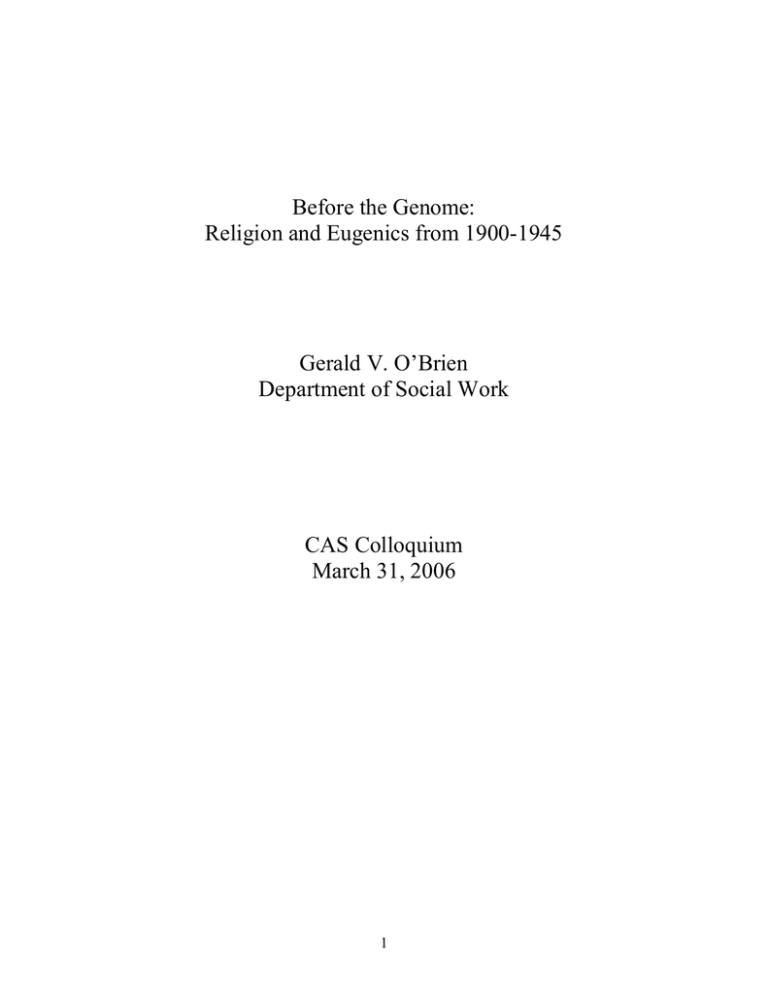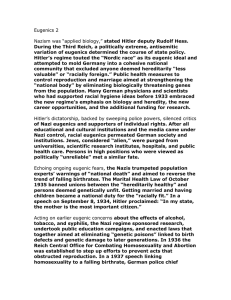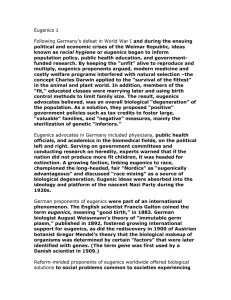Paper Competition - Winning Faculty Paper
advertisement

Before the Genome: Religion and Eugenics from 1900-1945 Gerald V. O’Brien Department of Social Work CAS Colloquium March 31, 2006 1 Charles Frankel wrote the following in 1974, decades before the human genome was mapped; [t]here hovers about biomedicine the scent of ancient taboos broken, of entry into forbidden territory. It stirs to life fears that go back to the oldest myths in our civilization, and revives religious attitudes about sin, trespass, and tinkering with the delicate harmonies of the Creation that lie just below the level of consciousness even in agnostics and atheists. (p. 29) Since controlled human breeding, or eugenics, deals with the elemental structure and composition of individuals and groups, and seeks to change this composition in profound ways, it has often been viewed as an intrusion on the designs of God. We hear a great deal today about the religious significance of contemporary developments in genetic testing and other forms of biogenetic research, and religious leaders struggle to decide how these developments interrelate with their theological teachings. This paper will discuss some of the historical background to this discussion, as I will consider how eugenic supporters during the first half of the century attempted to meld their program with mainstream Christianity. While I will discuss eugenics in both the United States and Nazi Germany, it needs to be noted that the eugenic movement had a very different face in Hitler’s Germany than it had previously shown in the U.S., and that the challenges faced by eugenic supporters vis-à-vis religious concerns were also very different. This being said, the efforts of eugenicists to demonstrate that their goals were in keeping with religious doctrine were, in many ways, quite similar in both countries. 2 The Eugenic Alarm Period With roots in the nineteenth century, the eugenics movement emerged as a major social force in the United States following the 1900 rediscovery of Mendel’s laws of inheritance. Based largely on the writings of England’s Sir Francis Galton (1870; 1907), the movement held that the human species could be improved through the systematic control of breeding practices. Eugenics was widely viewed by many as an applied form of husbandry, and many of its supporters noted the gains that had been made through the planned and controlled breeding of non-human animals. If, as with these other animals, a nation could develop methods to ensure that those with “desired” characteristics bred more (termed “positive eugenics”) while at the same time diminishing the breeding of those with “undesirable” characteristics (termed “negative eugenics”), the species would presumably evolve to a more advanced level (Kevles, 1985). In the United States, early eugenics was inextricably connected to care and treatment of disabled persons, and especially persons who were diagnosed as “feeble-minded” (O’Brien, 1999; Smith, 1985). The feeble-minded classification included the subcategories of, from lowest to highest in “intellectual capability,” idiots, imbeciles and morons. These persons, and especially the morons, were believed to be the nucleus from which a wide range of social evils, including immorality, criminal behavior, and poverty, emanated. Moreover, eugenic supporters argued that in the vast majority of cases feeble-mindedness was the result of heredity, and therefore enhancing the environmental opportunities such persons were afforded would do little to improve their lot. The fear that fueled the eugenics movement was enhanced by the birth differential argument, as supporters of eugenic control argued that the moron population was expanding far more quickly than the “regular” population, and that these persons would 3 eventually become the dominant class within the nation (Gould, 1981). Following the turn of the century, institutional development flourished, pushed forward by eugenic family studies such as the Kallikaks, and the widespread dissemination of propaganda that supported forced segregation as the most feasible method of controlling the feeble-minded portion of the population (Trent, 1994). Other than institutionalization, the most important method of eugenic control initiated during the eugenic alarm era was involuntary sterilization (Reilly, 1991). Many eugenic advocates favored this as a method of control since it was less expensive than institutionalization. It could also be viewed as more “humane” than long-term segregation, since it allowed sterilized individuals to live in the community, constrained only in their ability to reproduce (Popenoe & Johnson, 1933). During the first three decades of the twentieth century, tens of thousands of persons who were diagnosed as feeble-minded or insane were institutionalized and/or sterilized for eugenic purposes. The most important eugenic legal victory came with the Supreme Court’s Buck v. Bell decision in 1927 that allowed – by an overwhelming 8-1 ruling – the states to practice involuntary sterilization. Many eugenicists were also involved in the immigration restriction debate. In presenting pseudo-scientific data that seemed to demonstrate that many of the newer immigrants that were entering the country were mentally or physically disabled, eugenicists played an important role in supporting the xenophobia that swept America following World War I. What good was it, many argued, to institutionalize and sterilize disabled Americans if more entered the country through immigration? Important eugenicists, most notably Harry Laughlin of the Eugenic Record Office, were instrumental in supporting the development of the restrictive immigration acts of 1921 and 1924, which severely limited the number of immigrants allowed into the country (“Europe as an Immigrant- Exporting …,” 1921). 4 While the American movement would live on beyond the Great Depression, the hysterical fear of the moron, which had been its central driving force, lost impetus between 1915 and 1930. Institutional administrators and others came to admit that many cases of moronity were not genetic, and that cultural factors such as poverty put many persons at risk for a feebleminded diagnosis (Deutsch, 1938). Intelligence tests too were increasingly called into question, especially as presumably “normal” persons came to be increasingly diagnosed as morons (Gould, 1981). By the 1930s, the primary supporters of eugenics in the United States who remained active in the movement were persons who believed that eugenic goals could be extended beyond targeting simply persons and families with “degenerate” qualities, but could also diminish the percentage of lower “race types” within the nation. It was this segment of the American movement, as one might assume, that directly influenced German notions of race hygiene, both prior to and during the Third Reich (Kühl, 1994). Eugenics in Germany under Hitler While a eugenic faction had developed in Germany prior to Hitler’s ascension to power, it had little success in policy formation. Indeed, influential German eugenicists looked with envy at the gains wrought by the American eugenicists, especially the state sterilization laws (Kühl, 1994). Hitler’s own interest in eugenics was an integral component of his overall scheme of race hygiene, and was widely disseminated a decade before his rise to power throughout the pages of Mein Kampf (1971). He wrote, for example, that; A prevention of the faculty and opportunity to procreate on the part of the physically degenerate and mentally sick, over the period of only six hundred years, would not only 5 free humanity from an immeasurable misfortune, but would lead to a recovery which today seems scarcely conceivable. (pp. 404-405) Hitler proposed that measures of both negative and positive eugenics be developed to reverse race suicide in Germany. With his rise to power in 1933, the physicians and other professionals who shared his philosophy of racial eugenics took control of the medical infrastructure within the nation (Weiss, 1987). Within his first year in power, he instituted a sweeping eugenic sterilization law that was targeted at persons with mental and physical disabilities. This policy would put Germany in the forefront of the eugenics movement, and by the time the program ran its course approximately 400,000 German citizens had been forcibly sterilized. The German medical community largely supported the policy, not only because those who failed to ally themselves with the Nazis jeopardized their positions, but also because they could point to the United States as leading the way, as thus providing moral cover, for their program (Proctor, 1988; Weindling, 1989). In 1939, with the onset of their attack on Poland that marked the beginning of World War II, the Hitler government covertly implemented its most horrendous eugenic policy, the T4 euthanasia program. While the Nazis had been discretely murdering thousands of disabled children and adults in institutions over the previous years, the T4 program instituted the assembly-line killing apparatus that would characterize the Holocaust. The timing of the program is important, as the Nazis realized that they could more easily get away with the program during wartime (Weindling, 1989). Prior to their utilization at the Holocaust sites, gas chambers were first installed and “perfected” in six mental institutions. These facilities, over the course of a four year period, took in and murdered approximately 70,000 persons from throughout Germany who were diagnosed as disabled, with the vast majority of these being labeled as “feeble-minded” or 6 “insane.” The program ended around 1942, and the institutional apparatus and employees were removed to the eastern territories to help carry out the Holocaust. The killing of persons with disabilities, however, would continue unabated until the end of the war, although the Nazis would resort to their earlier forms of murder, such as starvation and poisoning (Burleigh, 1994). Religion and Eugenic Support Sir Francis Galton was the most important early supporter of eugenic control to invoke it as a religious tenet. He wrote that the subject “must be introduced into the national consciousness as a new religion.” Eugenics has, he continued, “strong claims to become an orthodox religious tenet of the future,” since it “co-operate[s] with the workings of nature by securing that humanity shall be represented by the fittest races” (1904, p. 5). In another work he added that eugenics “ought to find a welcome home in every tolerant religion,” since it “extends the function of philanthropy to future generations.” Eugenics, he added, was unlike mainstream religions, however, since it “sternly forbids all forms of sentimental charity that are harmful to the race, …” (1996, pp. 68-70). A primary challenge that faced eugenic supporters, however, was trying to convince a wary pubic that practices such as forced institutionalization and sterilization were ethical and in keeping with mainstream religious beliefs. Efforts to force breeding standards on the population, or to have a cadre of specialists who could decide who should and should not have children were, as one might expect, not met enthusiastically at the beginning of the twentieth century. Most eugenicists understood both that their program could be viewed as an act of hubris that infringed on God’s domain and that talk of displacing or surpassing Christianity would only diminish their support among the 7 public. They needed to rhetorically describe their goals, then, so that they would be acceptable to the public and religious leaders and seem congruent with existing religious precepts. Building a Conceptual Relationship between Religion and Eugenics The principle means by which eugenic supporters attempted to curry public support for their proposals was by the dissemination of arguments that, to them, at least, demonstrated that eugenic control was compatible with, rather than antithetical to, mainstream Christianity. These arguments included the contention that both eugenics and Christianity; a) aided in the progression or perfectibility of humankind, and conversely supported an end to human “degeneration,” b) held the intellectual nature of the species to be a God-given gift to be cherished and fostered, c) sought an end to rampant immorality, and d) were efforts to aid the less fortunate. Each of these arguments will now be discussed in turn. The Progression of the Species and Human Degeneration Many eugenic supporters contended that their primary goal was to support the “upward” progression of the species. For a central component of Christian thought is that God is perfect, and that humans, in order to approach a high degree of spiritually, must strive for perfection. This “perfection,” eugenicists argued, could be attained only with the aid of conscious birth selection. Leon Whitney wrote in 1926 that “God loves perfection. This great strain which God or nature developed by the kindly selective process was no doubt much greater than the race from which it sprang and must have 8 been very dear unto God” (p. 4). By helping to foster this more perfect species, Peter Bryce added (1918), they were “apostles of a social ethics” (p. 656). Rather than moving toward perfection, eugenicists generally held that the efforts of the species to draw closer to God had become compromised because of large-scale degeneration, which was mainly caused by the uncontrolled and rampant breeding of the “less evolved” portion of the population. Many eugenicists who held a social Darwinist perspective contended that if “encroaching on God’s realm” was a primary reason for opposing eugenic policies, the development of medical, public health, and other environmental and social reform measures that kept alive persons who previously would have perished could also be viewed as subverting divine intent. In counteracting these unnatural preservation measures, not by killing the unfit, but simply by ensuring that they would not breed, eugenicists argued they were serving to keep the stock from becoming polluted. As Walter Hadden wrote in 1914; The world cannot go on deteriorating, and degenerating without ruining the designs of God that man shall aim for the highest things in life. Nowhere can it be found that the Almighty while insisting upon reproduction, insists that it shall be carried on without reason and common sense. … To reach perfection was the constant insistence of Christ. In the Sermon on the Mount, addressing the multitude he said: ‘Be ye therefore perfect, even as your Father which is in heaven is perfect.’ There is no justification here for perpetuating imperfection, but the contrary. (p. 9) “It was not God,” Huntington and Whitney wrote in 1927, “who made the defectives. We made them, or our forefathers did. God kills them off, for that is Nature’s 9 stern way; we make them by disregarding the laws of heredity, by reserving the weak and imbecile, and by making it easy for defectives to reproduce their kind” (p. 136). In her book Race Improvement or Eugenics, LaReine Baker (1912) called racial degeneration the scientific equivalent of “the theologian’s ‘fall from grace’” (pp. 55-56). As was the case with some of the American eugenicists, Hitler contended in Mein Kampf that a program to control the breeding of humans in order to create a more perfect race was an important way of ensuring that God was presented with the type of humans that He truly deserved; a race that reflected both the presumptive moral and aesthetic features of the deity. It was only by putting “an end to the constant and continuous original sin of racial poisoning,” he wrote, that humans could “give the Almighty Creator beings such as He Himself created” (p. 402). The Intellectual Nature of Man as Our Bridge to the Spiritual The vast majority of those who were targets for eugenic control, both in the United States and Nazi Germany, were not just persons with disabilities, but, more specifically, individuals with cognitive or psychological disabilities. This primarily included persons who had been diagnosed as feeble-minded or insane. An undercurrent of the eugenic argument in both countries was that intelligence and reasoning were the characteristics that placed humans over other animals, and that those members of the species who did not have minimal levels of cognitive abilities were not fully functioning human beings, or at least did not deserve the full spectrum of human rights. This belief was a holdover from the Great Chain of Being, which was an important philosophical construct from the eighteenth and nineteenth centuries. The 10 Chain was a vertical scale on which all physical and spiritual (e.g., angels, saints, God) entities were placed according to their presumed level of perfection, complexity or perceived valuation. According to Arthur Lovejoy (1966), humans were traditionally viewed as holding a place in the middle of the Chain, since, through our dualistic nature as physical and intellectual beings, we link the ‘animalistic’ and the ‘spiritual’ segments of the continuum (p. 198). It has often been contended that humanity is linked to its brutish past, and the anthropoids from which we evolved, by means of the “lowest” humans. Conversely, the spiritual realm may be seen as connecting with homo sapiens by way of the “highest,” or most intellectual, insightful or moral members of the species. Inherent in this philosophy, as many have viewed it over time is a belief that the species has evolved from its material or animalistic origins, and is continuing to evolve toward a spiritual plane. As Harriet Ritvo wrote (1995), “[c]orollary to this fundamental human/animal dichotomy is the notion that what is good in people reflects their closeness to god (or their divine nature), and what is bad in them reflects their closeness to animals (or their bestial nature)” (p. 482). Hitler, for example, wrote (1971) that if eugenic standards for marriages were set, matrimony could become “an institution which is called upon to produce images of the Lord and not monstrosities halfway between man and ape” (p. 405). Eugenic advocates, in both subtle and obvious ways, fostered the belief that those humans who were the most “perfect,” especially in their reasoning ability, were the most evolved members of the species, and thus had the greatest affinity to God. How could one reconcile, they wondered, the knowledge that man was created in God’s image with the existence of persons who were severely disfigured or disabled? 11 The Immorality of the Moron and other “Degenerates” In 1934, Dr. Theodore Robie, a vocal supporter of eugenic control, discussed the case of the daughter of a “mentally defective father” who “contracted gonorrhea at eight-and-a-half years as a result of a supposed rape by a man of fifty-two.” Did Dr. Robie express outrage at this rape of an eight-and-a-half year-old? Quite the contrary, he assumed that “considering her low mental capacity it is more than probable that she made little effort to prevent this assault” (p. 204). While being an extreme example, this quote is indicative of the effort that was made throughout the eugenic period to portray the moron as the primary source of sexual immorality within the nation. A prevalent theme of eugenic propaganda was that males were likely to take advantage of young children or “vulnerable” women, and the females were sure to become prostitutes and to bear large numbers of illegitimate progeny. In their presumed hypersexuality morons stood out as not only consummate sinners, but moreover as persons who were apt to lead others to engage in evil. Thus, eugenic supporters argued that programs which kept these persons from engaging in sexual activities were in keeping with religious precepts to diminish sinfulness. Early supporters of eugenic castration even supported this measure as a necessary means of responding to rampant masturbation, especially among feeble-minded youths (Riseley, 1905). It was particularly the female moron who was considered to be sexually perverted and a principle source of societal “pollution.” Many eugenicists were obsessed with the reputed sexual exploits of these women, and most eugenic family studies could be traced back to the debouched female. It was generally the fear of sexual promiscuity, or the birth 12 of a child out-of-wedlock, that would precipitate efforts to forcibly segregate or sterilize (or, in the case of Rosemary Kennedy, lobotomize) females classed as morons or “highgrade” imbeciles. If such a woman, Popenoe and Johnson (1933) wrote, “had behaved herself she would have been kept at home in many instances” (p. 154). As Kline (2001) noted, normality – and therefore also moronity – was defined as much by “moral purity” as it was by “mental capacity” (p. 121). “For Their Own Good: The Altruistic Argument The contention that feeble-minded persons benefited from and, in many cases, even desired measures of control – or would have could they make a reasoned decision – was a principle theme of eugenic writings. Institutionalization, sterilization and other restrictive policies, these writings held, would not only protect society from the burdensome weight of future morons, but also were in keeping with the public’s Christian duty to provide for and protect such unfortunates who could not live on their own, and were constantly threatened by the dangers of their environment. Thus discussions regarding the proper course of care given to feeble-minded persons were filled with paternalistic arguments that presented institutional administrators and other authorities as benevolent caregivers who were sacrificing their time and energy to protect the moron and provide them with a higher quality of life than they otherwise could be expected to have. Many eugenicists, especially institutional administrators, argued that it was only within a properly run institution that morons would be happy. Alexander Johnson (1908) 13 invoked the teachings of Jesus in calling for the segregation of feeble-minded children as a means of protecting them; the Master said that it was better for us to have a mill-stone around our necks and to be cast into the depths of the sea, than that we should cause one of these little ones to offend, …The attitude of the state should be that of a good and loving mother to them. (p. 336) Just as sexual segregation was rationalized as being in the best interest of the morons as well as the society at large, so was sterilization. It is certainly ironic, then, that one of the principle benefits of sterilization is that it would allow persons to leave the institution. The procedure itself was described by eugenicists as “humane,” “minor,” “trivial,” and a “simple and harmless” practice. Most operations were “not performed under duress and legal pressure,” one supporter noted, “but are merely instituted through persuasion of the individuals on the part of tactful physicians and prison officials” (Stoddard, 1923, p. 249). Paul Popenoe and E.S. Gosney (1929), two leaders of California’s massive race betterment program, were committed advocates of sterilization who frequently noted that those who were subject to the operations were among its biggest supporters. They noted that many of the women who received the operations, even involuntarily, were “pathetic in their expression of gratitude and their wish that other women” in similar circumstances would “have the same protection” (pp. 30-33). In Hitler’s Germany, even euthanasia was rationalized as being in the best interest of its victims. The language of “release,” “salvation,” “special treatment” and “deliverance” was frequently employed by the Nazis in discussing the program, and such terms often served as “code words” within official memorandum. A condolence letter 14 sent to the family of a victim of the program noted that his death – from a fabricated cause – was a “deliverance” since it “delivered him from his suffering and spared him from institutionalization for life” (Müller-Hill, 1988, p. 104). In addition to allowing social control agents to position themselves as advocates of their victims, this rhetoric also sought to provide a quasi-religious aura to eugenic arguments. The Employment of Religious Metaphors and Symbols in Eugenic Writings As the examples above demonstrate, those who wrote in support of eugenic goals were especially prone to draw on religious metaphors and symbols to demonstrate the close relationship between their proposals and Christian principles. A number of those who wrote in support of the movement assured their readers that the primary symbol of these faith communities, Jesus himself, would back their measures. Albert Wiggam (1923) declared that “had Jesus been among us, he would have been president of the First Eugenics Congress” (p. 110). Another supporter of eugenic control noted that Jesus “was born into the world without any hereditary taint.” This physical and mental normalcy, he continued, “is what he craved for every other child of God” (Reccord, 1918, p. 381). Moreover, just as Jesus had sacrificed himself for the good of the world, eugenicists, especially in Nazi Germany, invested the concept into their own writings, with “the victims ‘sacrificing’ themselves for the good of the collective” (Burleigh, 2000, p. 358). Biblical verses too, especially the teachings of Jesus, were often invoked as examples to demonstrate that eugenic measures were in keeping with the principles of Christianity. Leon Whitney (1926), for example, described the parable of the sower as analogous to eugenics. As the story goes, a man who sowed good seeds in his field came 15 to find that weeds also had grown up, the latter being the product of an enemy who “came and sowed tares among the wheat” while the owner slept. When harvest came, the wheat was to be gathered and placed into barns, while the “bad seed” was to be burned to ensure that it would no longer grow. Whitney concluded that in following out this injunction, church leaders must join forces with eugenicists and “do their part in seeing that the seed from the human tares does not go over into the next generation” (p. 4). Wiggam (1923) contended that eugenics was “simply the projection of the Golden Rule down the stream of protoplasm.” The “biological Golden Rule,” he said, was to “[d]o unto both the born and the unborn as you would have both the born and the unborn do unto you” (pp. 110111). The small number of American eugenicists who supported euthanasia as a viable control measure even invoked religious symbols and metaphors to buttress their positions. In discussing the famous Bollinger baby case of 1915 wherein a physician refused to treat a disabled newborn, who quickly died, a physician wrote “[t]he human body, we are told, is the temple of the living God.” A body like that “of the babe in question,” he continued, “would be a poor receptacle for the indwelling Holy Spirit.” (Was the Doctor Right? 1916, p. 23). As noted above, the Nazis employed religious rhetoric profusely in their writings and films that supported eugenic programs, including the euthanasia program (Burleigh, 1994). They also appropriate the Ten Commandments, disseminating a list of “Ten Commandments for the Choice of a Mate.” These included Commandment #2, “If you are hereditarily healthy, you should not remain unmarried,” Commandment #5, “As a 16 German, choose only a spouse of the same or Nordic blood,” and Commandment #6, “In choosing your spouse, ask about his ancestors” (cited in Bock, 2004, p. 72). Activities to Engage Religious Leaders in the Eugenics Movement One last way in which eugenicists, especially those in the United States, attempted to show that their goals were in keeping with Christian teachings, was to solicit the support of clergy. Eugenic leaders such as Charles Davenport and Harry Laughlin called on mainstream churches and their leaders not only to support but also take a leading role in the movement. In 1926 the Eugenical News announced that the American Eugenics Society was holding a competition for those preachers who could best incorporate the issue of eugenics into their sermons. This competition, the announcement noted, was “open to any minister, priest, rabbi or student in a theological seminary of any denomination.” The Society also printed a “Eugenics Catechism,” and formed a “Committee on Cooperation with Clergymen” (“Prizes for Sermons on Eugenics,” 1926, p. 48). Both the eugenic sermon competition and the Committee met with success, although religious leaders responded more to the “social message of eugenics rather than its scientific details” (Rosen, 2004, p. 122). Ministers, priests and other clerics and religious leaders were especially desirable allies for those in the eugenics movement because of their roles in facilitating marriage bonds. Since an important goal of the movement was to ensure that prospective mates had considered each other’s hereditary fitness prior to marriage, and many eugenicists fought for state laws that would restrict marriage among the “unfit,” they also realized that the cooperation of those who administered marriages was essential. Even without 17 such legislation, some members of the clergy, led by Rev. Walter Sumner (1914), agreed to refuse to marry couples unless they could produce health certificates providing evidence that they did not have a hereditary or communicable disease (p. 510). In her book Preaching Eugenics, Christine Rosen (2004) describes the relationship between the eugenics movement and religious leaders in great depth. According to Rosen, a large number of clerics, especially liberals with a social reform outlook, took up Sumner’s call to only marry couples who could demonstrate eugenic “fitness.” Progressivism and its focus on prevention and amelioration of disease and social problems had an important influence in many Protestant churches, and a large number of religious leaders, like Sumner, believed they could help usher in “the Kingdom of God on earth through reform and service” (pp. 53-55; 59-61). Conclusion The employment of religious rhetoric and religiously-slanted arguments within the context of eugenic writings had the primary purpose of demonstrating that controlled human breeding could be a complementary practice to Christianity. The logic of eugenicists was clear. If God was perfect, and wanted humans to become as much like “him” as possible, the perfectibility of humans was not only permissible but a divine mandate. They contended that this was especially important since, through medical and sanitation advancements and other means of social reform, humans had effectively overturned the natural or divinely ordained agents of differential population control. In the end, however, the efforts of eugenic supporters to curry favor with the church-going public was, it appears, largely ineffective. For the qualms many had of 18 eugenic control were even deeper than religious objections. As the movement progressed, and negative eugenic methods such as sterilization expanded to an ever-increasing segment of the population, many probably wondered how long they and their families would remain untouched by policies of negative eugenics. While a number of religious leaders came to accept some forms of eugenic control, especially marriage restriction, others were wary of the movement. Moreover, some were angry that eugenicists were challenging their territory, and attempting to tell them how to effectively carry out the functions of their jobs. A new generation of scientists and researchers are now engaged in bioethical research. While there are indeed comparisons to be made between some of these advancements and historical eugenics, in some ways the similarities are overstated, and constitute simple fear-mongering. However, those who support these new procedures, as well as the public policies to fund and implement the technologies, will be faced with a number of public relations challenges similar to those that faced eugenic supporters a century ago. Close to the top of that list is that they will need to demonstrate that God is indeed on their side. 19 Bibliography Baker, L.H. (1912). Race improvement or eugenics: A little book on a great subject. New York: Dodd, Mead and Company. Bock, G. (2004). Nazi sterilization and reproductive policies.” In Deadly Medicine: Creating the Master Race (pp. 61-88). Washington D.C.: United States Holocaust Memorial Museum. Bryce, P.H. (1918). Feeblemindedness and social environment. American Journal of Public Health, 8, 656-660. Burleigh, M. (1994). Death and deliverance: ‘Euthanasia’ in Germany 1900-1945. Cambridge: Cambridge University Press. Burleigh, M. (2000). The Third Reich: A new history. New York: Hill and Wang. Deutsch, A. (1938). The mentally ill in America: A history of their care and treatment from colonial times. Garden City, NY: Doubleday, Doran and Co. Europe as an emigrant-exporting continent and the United States as an immigrantreceiving nation. (1924, March 8). U.S. House of Representatives, Committee on Immigration and Naturalization. Testimony of Harry H. Laughlin, 1231-1318. Frankel, C. (1974, March). The specter of eugenics. Commentary, 29. Galton, F. (1870). Hereditary genius. New York: D. Appleton and Co. Galton, F. (1904). Eugenics: Its definition, scope, and aims. The American Journal of Sociology, 11, 1-25. Galton, F. (1907). Inquiries into human faculty and its development. New York: E.P. Dutton & Co. 20 Galton, F. (1996). Eugenics as a factor in religion. In Essays in Eugenics (orig. pub. 1909; pp. 68-70). Washington, DC: Scott-Townsend Publishers. Gosney, E. and Popenoe, P. (1929). Sterilization for human betterment. New York: The MacMillan Company. Gould, S.J. (1981). The mismeasure of man. New York: W.W. Norton and Co. Hadden, W.J. (1914). The science of eugenics and sex life (2nd edition.). W.R. Vansant. Hitler, A. (1971). Mein kampf (Reprint). Translated by Ralph Manheim. Boston: Houghton Mifflin Co. Huntington, E. and Whitney, L.F. (1927). The builders of America. New York: William Morrow and Co. Johnson, A. (1908). Custodial care. Proceedings of the National Conference of Charities and Correction (pp. 333-336). Press of Fort Wayne Printing Co. Kevles, D.J. (1985). In the name of eugenics. New York: Alfred A. Knopf. Kline, W. (2001). Building a better race: Gender, sexuality and eugenics from the turn of the century to the baby boom. Berkeley: University of California Press. Kuhl, S. (1994). The Nazi connection: Eugenics, American racism, and German National Socialism. New York: Oxford University Press. Lovejoy, A.O. (1966). The Great Chain of Being. Cambridge, MA: Harvard University Press. Müller-Hill, B. (1988). Murderous science: Elimination by scientific selection of Jews, Gypsies and others: Germany 1933-1945. Translated by George R. Fraser. New York: Oxford University Press. 21 O’Brien, G.V. (1999). Protecting the social body: The use of the organism metaphor in fighting the ‘menace of the feeble-minded.’ Mental Retardation, 37, 188-200. Popenoe, P. & Johnson, R.H. (1933). Applied eugenics. New York: The MacMillan Co. Prizes for sermons on eugenics. (1926). Eugenical News, 11(3), 48. Proctor, R.N. (1988). Racial hygiene: Medicine under the Nazis. Cambridge: Harvard University Press. Reccord, A.P. (1918). A perfectly normal child. The Survey, 41, 381. Reilly, P.R. (1991). The surgical solution: A history of involuntary sterilization in the United States. Baltimore: Johns Hopkins University Press. Risley, S.D. (1905). Is asexualization ever justifiable in the case of imbecile children? Journal of Psycho-Aesthenics, 9(4), 92-98. Ritvo, H. (1995). Border trouble: Shifting the line between people and other animals. Social Research, 62, 481-500. Robie, T. (1934). Selective sterilization for race culture. In A decade of progress in eugenics (pp. 201-209). Baltimore: The Williams and Wilkens Co. Rosen, C. (2004). Preaching eugenics: Religious leaders and the American eugenics movement. Oxford: Oxford University Press. Smith, J.D. (1985). Minds made feeble: The myth and legacy of the Kallikaks. Austin, Texas, Pro-ed. Stoddard, L. (1923). The revolt against civilization. New York: Charles Scribner’s Sons. Sumner, W.T. (1914). The health certificate - A safeguard against vicious selection in marriage. In Proceedings of the First National Conference on Race Betterment (pp. 443-449). Battle Creek, MI: Race Betterment Foundation. 22 Trent, J.W. (1994). Inventing the feeble mind: A history of mental retardation in the United States. Berkeley: University of California Press. Was the doctor right? Some independent opinions. (1916). The Independent, 85(3500), 23-27. Weiss, S.F. (1987). Race hygeine and national efficiency-the eugenics of Wilhelm Schallmeyer. Berkeley, CA: University of California Press. Weindling, P. (1989). Health, race and German politics between national unification and Naziism, 1870-1945. Cambridge: Cambridge University Press. Whitney, L. (1926). The source of crime. New Haven, CN: The American Eugenics Society. Wiggam, A.E. (1923). The new decalogue of science. Indianapolis: Bobbs-Merrill Company, 1923. 23







